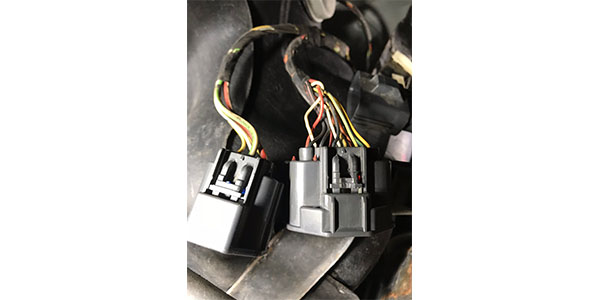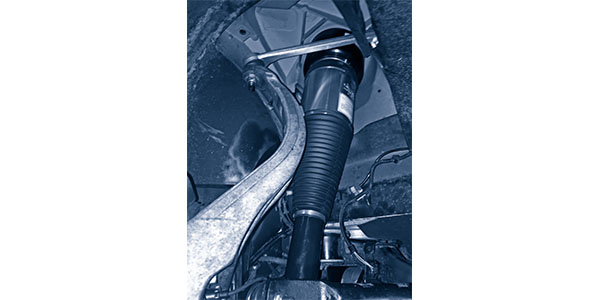
It is a common occurrence on the coldest days or during large fluctuations in the temperature to get a customer call or visit complaining that they have a warning message on their dash telling them the air ride suspension system is malfunctioning or there is a fault.
When you scan the vehicle, there might be active or stored plausibility or rationalization codes for a pump, reservoir or air spring. These codes don’t tell you if there is a leak, blown fuse or weak pump. In most cases, the vehicle is not riding low and the customer does not notice any other problems. By the time it gets to your shop or sets for more than 30 minutes, the air suspension could be working just fine and the message could be gone. Some techs might want to fire the parts cannon at the problem, but it might not cure the weather-induced light.
These types of plausibility faults are usually set by parameters from the air ride module for a certain action to cause an expected result. Think of it as an EVAP system. Codes might be related to the time it takes for the compressor to replenish the reservoir, or the time it takes to carry out a trim adjustment. If it takes too long, the control module will assume there is a problem and puts the vehicle into a safe mode to preserve the compressor and airbags.
While these observations by the system could be the result of a leak, these faults are more likely the result of a weak compressor, sensor or a problem with the solenoids controlling the system.

Sensors
There are three types of sensor information a vehicle uses to trim the ride height and regulate the compressor: temperature, pressure and ride height. Temperature is a major parameter for air ride. Air density and pressure can vary widely due to temperature. This is called Charles’s Law.
If a driver with an air ride suspension drives their vehicle home from work with an outside temperature of 32ºF, and the brakes also heat the air in the bladders, the air’s volume in the bladder expands. If the driver parks the car overnight and wakes up to a 10ºF morning, the air inside the bladder will have contracted and there will be less volume and pressure to support the vehicle. When he walks outside, the car will be riding lower. Some systems will wake up to retrim the vehicle at predetermined intervals with the air in the reservoir. But, air temperature also impacts the reservoir. As the temperature decreases, the amount of air in the reservoir also decreases. This means there is less air to trim the vehicle.
Charles’s Law also applies to compressors. If air intake temperature is lower, there is more dense air that can be used by the compressor. In that case, the time to pressurize the reservoir should be reduced.
The control module will look at ambient temperature and other factors to determine when and how long the compressor should run to generate the correct volume and pressure to fill the reservoir or trim the vehicle.
Outside temperature can be determined by an ambient temperature sensor or, in some cases, it is the mass airflow sensor. Measuring air temperature is critical because it will decide how much time it will take the compressor to fill the air springs and reservoir.
Hall effect sensors at the wheels measure wheel travel. These sensors measure the ride height of the vehicle. But, the data generated is used to determine if a correction or adjustment was effective by measuring the time it takes to make an adjustment.
Pressure sensors are typically mounted in the reservoir, compressor or control block. Most systems will measure the pressure only at the reservoir and maybe at each axle. Pressure sensor input is used to determine compressor output and not the pressures that go to the wheels. Most systems look at ride height instead of pressure to trim the vehicle.
Codes
The codes for cold-weather problems will typically include the words “replenish,” “reservoir,” “overheat,” “no pressure increase” or “timed out.”
There are two main culprits for these codes: a weak compressor or a leak in the system. It is possible that a sensor in the reservoir is faulty, but this is extremely rare.
Codes may require a scan tool that can communicate with the air ride system, and the codes may be proprietary to the make and model. Also, a good scan tool can perform bi-directional tests and calibrate the system.
In addition, most advanced air ride systems are on the CAN bus. It is possible that missing CAN signals due to a communication error can cause a malfunction message to be displayed.
Reservoir Logic
An air ride system performs a lot of work when the keys are not in the ignition. The system will trim the ride height to make sure the vehicle is not sitting on the ground as the air in the bladders cools and contracts. During winter, the temperature difference between when the car was parked and when it is started in the morning can cause a system to set a fault message on a healthy system.
Also, some systems will keep a level ride height if the vehicle is parked on an uneven surface, or if the vehicle is unlocked and a load is placed in the trunk. But, most systems will never turn on the compressor to make a key-off correction.
Most fault messages will prevent the system from being used to its full capacity to trim the vehicle. Corrections are filtered so the least amount of pressure is used but the suspension will stay in a safe zone.
Most systems have fail-safe modes that preserve the system until it can be serviced or the abnormal conditions have passed. Most units will maintain minimum pressure or height in order to prevent a bladder from fully compressing and the suspension from bottoming out. But, if the car sits long enough with a small leak, the reservoir will become depleted.
It is critical to solve all fault codes and leaks before replacing the air struts or shocks since blindly replacing these units may not address the root causes of the issue. Selling the customer an expensive repair only to have a fault message comeback is bad for your shop. Treat every air ride problem like an EVAP or driveability problem. Take the time to look at the service information for clues on how the system operates. Also, be sure to review air ride manufacturer websites for additional sources of information.














